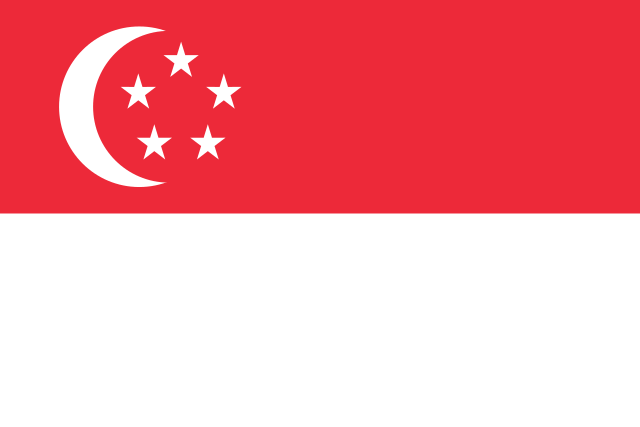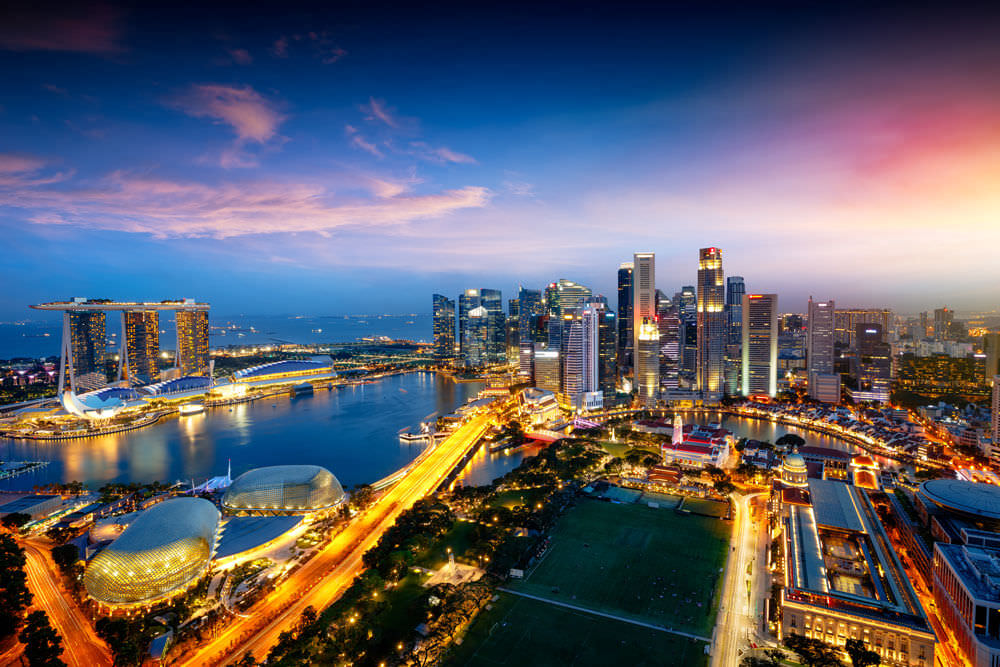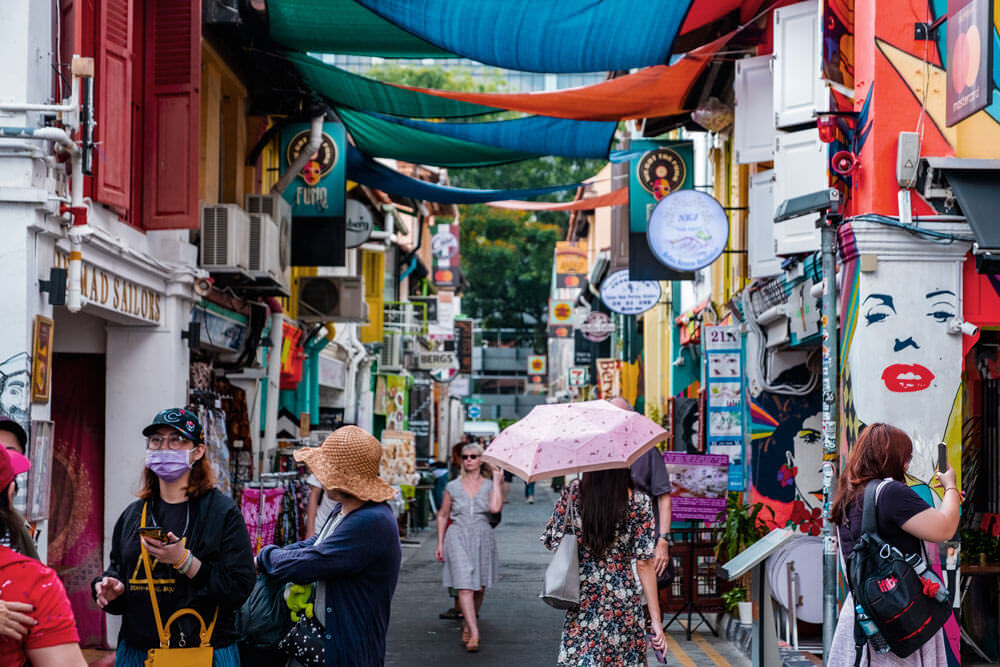Singapore

Land Area: 709km²
Time Zone: GMT+8
GDP: 396.99 billion
Main industries: Banking, Biotechnology, Energy and infrastructure, Real estate, Tourism
Principle Exports: Electronic integrated circuits, Petroleum oils and oils from bituminous minerals, Gold, Medicaments, Turbo-jets, Turbo-propellers
Gained independence: 9 August 1965
Joined Commonwealth: 1965
United Nations HDI Ranking (2019): 0.938
Official language: English, Singaporean Mandarin, Malay, Tamil
Currency: Singapore dollar (SGD)
Singapore, city-state located at the southern tip of the Malay Peninsula, about 85 miles north of the Equator. It consists of the diamond-shaped Singapore Island and some 60 small islets. The main island occupies all but about 18 square miles of this combined area. Singapore is the largest port in Southeast Asia and one of the busiest in the world. It owes its growth and prosperity to its focal position at the southern extremity of the Malay Peninsula, where it dominates the Strait of Malacca, which connects the Indian Ocean to the South China Sea. Once a British colony and now a member of the Commonwealth, Singapore first joined the Federation of Malaysia on its formation in 1963 but seceded to become an independent state on August 9, 1965.

Demographics
Singapore’s population as of July 2022 is estimated to be 5,921,231. The population is divided into four categories Chinese, Malay (includes indigenous Malays and Indonesians), Indian (includes Indian, Pakistani, Bangladeshi, or Sri Lankan), and other ethnic groups (includes Eurasians, Caucasians, Japanese, Filipino, Vietnamese). The distribution is 74.2% Chinese, 13.7% Malay, 8.9% Indian, 3.2% other.
Migration has played a key role in Singapore’s development. As Singapore’s economy expanded during the 19th century, more and more Chinese, Indian, and Malay labor immigrants arrived. Most of Singapore’s pre-World War II population growth was a result of immigration. During World War II, immigration came to a halt when the Japanese occupied the island but revived in the postwar years. Policy was restrictive during the 1950s and 1960s, aiming to protect jobs for residents by reducing the intake of low-skilled foreign workers and focusing instead on attracting professionals from abroad with specialist skills. Consequently, the nonresident share of Singapore’s population plummeted to less than 3%.
History
The earliest historical evidence shows that the Singapore Island, then more commonly known as Temasek, was initially populated by pirates and fishermen and utilised as an outpost by the Sumatran empire of Srivijya. In 1025, the land was attacked by Rajendra Chola I, the ruler of the southern Indian Chola kingdom, and again in 1068. According to Javanese poetry, the Javanese king Kertanagara was said to have attacked the island during his conquest of Pahang and in 1365 described Temasek as a successful conquest of the Javanese empire. By the end of the 14th century, Temasek was usurped by the Sultanate of Malacca, and it is said that monks who came to and inhabited the land changed the name of the land to the city of Singapura (Lion City), later changed to Singapore.
In 1819, the English East India Company, led by Sir Stamford Raffles, came ashore the Island of Singapore after being deterred by the Dutch at Riau and came across some Chinese planters, aborigines and Malays. Upon arrival, he was told by the hereditary chief, called the temenggong, who was also the cousin of Abdul Rehman the Sultan of the Riau-Johor, that the Company was allowed to buy purchase the land upon the Sultan’s approval. Abdul Rehman was under the sphere of influence of the Dutch, thus when Raffles refused to acknowledge the suzerainty of Abdul Rehman and approached his elder brother, Hussein, to purchase land from instead, the Dutch protested the actions; however, the British company’s court of directors took no actions to stop Raffles despite acknowledging that he had transgressed. As tensions between the Dutch and the British grew, the governments decided to negotiate a treaty for the demarcation of borders to avoid further escalation of conflict. Under the Anglo-Dutch Treaty of 1824, the Dutch withdrew all claims over the Malay peninsula in return for the British withdrawing from all Dutch claims south of Singapore (present-day Indonesian territories) such as the Carimon Islands, Batam, Bintan and Lingin. By 1826, Singapore, Penang and Melaka were made into a unitary outlying residence of India and in 1830 the territory was put under Bengal as its residency, with Singapore as the capital. The territory became an official crown colony in 1867.
Due to the rapid development of Hong Kong that began in 1842 as a key port territory for the British coupled with the French occupation of Saigon and Haiphong, and the Dutch East Indies’ port development, Singapore’s trade was greatly hampered and sidelined. However, with the opening of the Suez Canal in 1869 and the creation of steamships, the Singaporean district of Tanjong Pagar went through rapid development; quaysides and a naval base were established that greatly boosted transit trade and the demand for tin and rubber in the industrial nations of the West propelled Singapore’s port development further, making it one of the greatest across the globe. In the aftermath of World War 1, Singaporean territory defences were galvanised and a large naval base was built to prevent invasion. During World War 2, Singapore was occupied by Japanese forces until September 1945. Upon regaining control over Singapore, the British made it a separate crown colony from the Federation of Malaya and in 1953 set up the Rendell Commission, headed by former ambassador to Belgium, George Rendell, to draft a new constitution for Singapore with the intent of instating self-governance. In 1955, the number of elected seats in the Legislative Assembly was increased to 25 (out of a total of 32). In April of that year, general elections were held and a coalition government was formed between two political parties, the Labour Front led by David Marshall, who became the chief minister, and the People’s Action Party (PAP) led by Cambridge-educated lawyer Lee Kuan Yew. Upon their electoral victory, talks began between them and London for Singapore’s self-governance. In 1957 Malaya gained independence and in the subsequent year Singapore’s status was changed from a colony to a sovereign state with new elections to be held in 1959. The PAP won a landslide victory, instating Lee Kuan Yew as the first Prime Minister, although an allegedly communist political party called the Socialist Front remained a sizeable opposition in the 60s and 70s which induced fear of a communist takeover; however, Lee Kuan Yew managed to retain influence.
In 1963, Singaporeans voted yes to a PAP plebiscite to join Malaya and the islands of Borneo which resulted in the creation of the Federation of Malaysia in September of that year. However, due to ethnic tensions, the Indonesian-Malaysian confrontation, and the fact that Singapore was not achieving the economic progress they hoped to gain for the merging, the government of Malaysia decided to separate Singapore from the Federation due to which Singapore became an independent republic on 9 August, 1965. By October 1971, British troops fully withdrew from Singapore, replacing the Anglo-Malaysian Defense Agreement (AMDA) with the Five Power Defense Arrangement, consisting of several bilateral defense arrangements and an agreement to consult each other promptly in the event of an attack on Singapore or Malaysia. Singapore began to implement more assertive policies to both boost economic development and expand their diplomatic goals within the region; sustained economic growth from the 1970s to 1990s led to Singapore earning its title as one of the “Four Asian Tigers” along with South Korea, Taiwan and Hong Kong, and in 1967 Singapore became a founding member of the Association of South-East Asian Nations. Lee Kuan Yew remained Prime Minister till 1990, and although he stepped down in 1990 the PAP remains the ruling party in Singapore till this day.
Key dates
1819 – Sir Stamford Raffles of British East India Company establishes trading post on Singapore island.
1942 – Singapore falls to Japan, which renames it Syonan (Light of the South).
1945 – Japan defeated. Singapore under British military administration.
1946 – Singapore becomes separate crown colony.
1959 – Self-government attained with Lee Kuan Yew as prime minister.
1971 – Last British military forces withdrawn.

Legal System and Government
Singapore is a republic with a parliamentary system of Government based on the Westminster Model. The Executive includes the Elected President, the Cabinet and the Attorney-General. The President is elected by the people and is empowered to veto government budgets and appointments to public office. The Cabinet comprises the Prime Minister and Ministers appointed from among the Members of Parliament and is responsible for the general direction and control of the Government and is accountable to Parliament. The Attorney-General is the principal legal advisor to the government and has the power and discretion to prosecute offenders.
The Legislature comprises the President and Parliament and is the legislative authority responsible for enacting legislation. Parliament is made up of elected, non-constituency and nominated Members of Parliament. The President’s assent is required for all bills passed by Parliament and he may in his discretion withhold assent to certain bills.
Being a former British colony, the legal system in Singapore is based on the English common law. The Chief Justice, who is appointed by the President, is the head of the Judiciary. The Judiciary is made up of the Supreme Court and the Subordinate Courts. The Supreme Court hears both civil and criminal matters and is separated into the Court of Appeal and the High Court. The Subordinate Courts consist of District Courts, Magistrates’ Courts, Juvenile Courts, Coroners’ Court and Small Claims Tribunals. A Senior District Judge overlooks the Subordinate Courts.
Economy
The economy of Singapore is a highly developed free-market economy. Singapore relies on an extended concept of intermediary trade to entrepôt trade, by purchasing raw goods and refining them for re-export. The country’s main exports include electronics, chemicals and services. Small and medium-sized enterprises (SMEs) are the backbone of the Singapore’s economic landscape. SMEs contribute about 40% of Singapore’s nominal GDP and employs 70% of Singapore’s total workforce of 3.35 million.
Singapore’s trade-to-GDP ratio is among the highest in the world, as of 2020, the ratio was 320%.The Port of Singapore is the second-busiest in the world by cargo tonnage and is the busiest transshipment port in the world. Singapore is also a regional, continental and global hub for the management and operations of various MNCs, with its strategic location in close proximity with other Asia-Pacific markets, along with its advanced connectivity and infrastructure as an airline hub and maritime port with a diverse array of destinations, fiber-optic communications, efficient road transport and public transport as well as its immigration policies being receptive to human capital. In addition, Singapore is a popular international tourist destination for various types of tourism, such as business tourism, MICE (Meetings, Incentives, Conferences, Exhibitions) tourism, medical tourism and urban tourism.
Trade
In 2020 Singapore was the number 36 economy in the world in terms of GDP (current US$), the number 19 in total exports, the number 17 in total imports, the number 10 economy in terms of GDP per capita (current US$) and the number 6 most complex economy according to the Economic Complexity Index (ECI).
In February 2022, the top exports of Singapore were Electrical Machinery Apparatus & Appliances Nes… (SGD16.9B), Petroleum & Products & Related Materials (SGD6.28B), Oil Bunkers (SGD2.78B), Office Machines & Automatic Data-processing Machines (SGD1.84B), and Organic Chemicals (SGD1.71B). In February 2022 the top imports of Singapore were Electrical Machinery Apparatus & Appliances Nes… (SGD14.1B), Petroleum & Products & Related Materials (SGD8.37B), Office Machines & Automatic Data-processing Machines (SGD1.53B), Miscellaneous Manufactured Articles Nes (SGD1.47B), and Telecommunications & Sound-recording & Reproducing Apparatus (SGD1.36B).
Investment Opportunities
Singapore is the fourth largest financial centre globally and the third richest in the world. It is home to the biggest foreign exchange centre in Asia-Pacific and the third largest worldwide, after New York and London.
Singapore has a large trade network that amounts to over 25 free trade agreements. This includes 15 bilateral and regional agreements among 15 countries as of January 2021. The country is also one of the largest export economy and importer. Singapore benefits from government policies that position the country as open to trade, attract foreign direct investment inflows and that welcome overseas business setting up shop on its shores. Its low corporate tax rate and low level of corruption attracts more than half of Asia’s global firms to locate their regional main office in Singapore.
Singapore’s proximity to other countries and key markets in the region open up many possibilities for investors and businesses based here. In fact, many Chinese and Australian producers and trading houses have major offices in Singapore, boosting its position as the region’s stand-out commodities hub.
Singapore is also appealing to investors as an offshore wealth management hub, with 58% of participants in a 2018 survey conducted by Asian Private Banker rating it as their preferred market, followed by Hong Kong and Switzerland.
Sources
https://www.britannica.com/place/Singapore
https://www.cia.gov/the-world-factbook/countries/singapore/#people-and-society
https://www.imf.org/en/Publications/SPROLLS/world-economic-outlook-databases
https://www.bbc.com/news/world-asia-15971013
https://www.mlaw.gov.sg/about-us/our-legal-system/
https://intracen.org/BB-2012-08-27-WTO-Trade-Policy-Review-Singapore
https://effectivestates.org/wp-content/uploads/2019/04/Singapore-The-Evolution-of-an-Entrepot.pdf
https://www.worldbank.org/en/programs/business-enabling-environment
https://data.worldbank.org/indicator/NE.TRD.GNFS.ZS?year_high_desc=true
https://www.maritimegateway.com/singapore-remains-the-worlds-busiest-transshipment-port/
https://www.heritage.org/index/country/singapore
https://oec.world/en/profile/country/sgp
https://www.thebalance.com/a-guide-to-investing-in-singapore-1979029
https://www.hsbc.com.sg/international/why-singapore-is-a-great-place-to-live-and-invest-in/